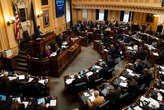When President Trump issued a freeze on federal grants and loans in late January, there was widespread confusion about what it could mean for countless programs that rely on that funding. For childcare providers, that funding can be a crucial source of financial support, since block grants and federal programs like Head Start enable them to serve low-income families who need affordable care.
The Trump administration later clarified that certain programs—including Head Start—would be exempt from the freeze, and Trump’s proposal was rescinded just days later. But the damage had already been done: Even a week later, there were reports that childcare providers could not access federal funds that they desperately needed to cover payroll and continue providing care to families. The National Head Start Association found that at least 45 providers could not access federal funds, potentially compromising care for nearly 20,000 children and families.
In the childcare industry, the steep cost of labor means that providers often operate with slim margins and have little to no financial cushion, leaving them in a precarious position. During the pandemic, many childcare centers only stayed afloat because the industry received billions of dollars in federal aid, which has since dried up.
Some childcare workers worry that they could still be impacted by a freeze on federal spending, even if their funding has not been stripped at the moment. Their concerns are not unfounded: Despite the rescinded memo and court orders blocking the freeze, the Trump administration has paused funding for a variety of other federal grants, according to multiple reports.
Fast Company spoke to two childcare providers who shared what it was like to navigate the aftermath of Trump’s proposal, and how a funding freeze could have impacted their ability to serve low-income families—or even keep their doors open. These conversations have been edited for clarity and length.
Amanda Schillinger, childcare administrator in Burnsville, Minnesota
For the entire time I’ve worked in [childcare], it has been an industry that struggles financially. You can only charge parents so much because they can only pay so much—but they can’t go to work if they don’t have childcare. So it’s a complicated system where it’s a needed service, but it’s a very expensive service to operate, and you have to have plenty of staff.
I always tell people, imagine having seven 2-year-olds all by yourself because in Minnesota, the ratio is one adult for every seven [kids]. Or imagine having four babies that you are responsible for feeding and caring for and educating and changing diapers—and how much work that would be.
I was checking news, like I do throughout the day, and [the funding freeze] popped up. My heart started to race. What does this mean? I know our childcare assistance comes from the block grants, which is a federal program. I know we’re on the food program, and that is also a federal program. I was like, are we not getting money anymore?
I spent the entire day trying to find any information, to find out: What does this mean? There was no information. Nobody knew. I had to sit down with our owner and say, hey, this is what’s going on right now. We need to start coming up with a plan.
Sixty-five percent of our students are served by the childcare assistance program. So I was like, how long can we operate if we aren’t seeing that money? And the owner [said] maximum 30 days. Having those students leave includes laying off staff. We can’t just indefinitely pay staff when we don’t have the students to pay for that. The food program pretty much pays for 100% of our food costs because we serve so many low-income families.
We have not run into issues at this time with accessing our funds. I know Head Start programs have still been having issues with that. Until this is completely settled, we still are working on all of our plans and contingencies. Could we float those families on childcare assistance for a period of time? Or is this something where once we aren’t getting reimbursed, we just can’t? So that’s one of the big things we’re having to look at—and that impacts staff and layoffs.
We are fortunate to live in a state that has invested in childcare. That has definitely made a huge difference here compared to so many states. We have a program that helps cover classroom staff costs, and those things help us have a little bit better footing. But don’t get me wrong—it’s not enough. If the funding freeze ever happened, it would be an absolute stretch to make it 30 days.
Christina Robles, childcare provider in Salt Lake City, Utah
I have been running a daycare from my home since 2013. I have some of my own traumas with childcare, so when I had my own daughter, I decided that I wanted to be able to provide care for those that were in my situation and give my daughter the social development that she needed at that time. Originally, I was only going to do it for a few years, and here I am with three locations.
Currently, I’m serving 48 families that are economically disadvantaged. I would say about 75% of my income comes from subsidized childcare, and the rest of it is out of pocket by parents, but that’s not the norm. I’m not in this for money. I’m in it to help the community. In addition to that, I also employ six single mothers because it gives them an opportunity to stay home with their children while making an impact on their life and get a livable wage. I pay $15 an hour to all of my employees, so it’s as livable as I can [afford] in this economy.
I walk a fine line between profitability and providing a safe space for children, where parents can trust that their children are being taken care of and taught. The pandemic funding [for childcare] made it possible for me to make big changes in my program so that I could reach more families, and it offset a lot of the cost for those parents and made it possible for me to grow in an industry that you can’t really grow in.
It felt like there was this tidal turn, where we were being seen, heard, and valued. When the government was investing in us, I was investing in my workers; we were investing in children. We were really starting to see a huge difference across the board. It allowed me to go from paying my employees $10 an hour to paying all of them $15 an hour or more. When that funding went away, it left a heavy, heavy burden on me.
When the news came down that there was a federal freeze, nobody knew what the heck that meant. Did that mean that was going to impact our food program? Nobody could answer, and they didn’t know when it was going to take place. For me specifically, that’s about $6,000 a month. That’s the income for at least two of my employees. And then, it would have impacted block grants. Like I said, 75% of my income comes from subsidized kids—so right there, that’s my entire livelihood.
I also serve children from Indigenous tribes. It’s a good 30% of my income at one of my locations. When a few days had gone by, and I was like okay, this [federal freeze] is not happening, I got a letter stating that their funds had actually been frozen. They did not have access to it, and they had no idea when they would be able to pay us, if at all. I literally wasn’t getting paid as of that moment—and that was $5,000.
It took about three weeks or so before we realized that the funding was coming through, and I didn’t end up actually having to front the cost. But I was going to. I had already had conversations with the Indigenous parents because I couldn’t imagine what they were going through. What would they have done? Where would they have taken their kids? Would they have been able to take time off? I had to sit down and have really tough conversations with all of my employees, who do an amazing job every single day. I was like I don’t know that I’m going to be able to make payroll. It was just so disheartening and stressful.
If I lose any federal funding, either I’m going to have to close my doors completely to all of my locations—that’s a real possibility—or I will have to change the clientele, and I will no longer be able to serve those underprivileged families who deserve an opportunity to have high-quality childcare.
I would literally have to say: You don’t make enough money. And how do you place value on someone with their economic status? How do you do that to a child? How do you do that to a family that you’ve created a lifelong bond with? I would be forced to only look at profits and numbers. That’s never how I’ve operated. But I cannot live in fear of this administration, and what they’re going to do. If I do that and I base my decisions off fear, I’m not doing any justice to my families that I serve.










No comments